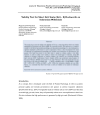

#Grit scale series
Results obtained from a series of hierarchical multiple regression analyses indicated that an academic-version of the Grit-S explained unique variance in academic emotional exhaustion beyond the variance explained by the domain-general version of the scale, and a sport-version of the Grit-S explained unique variance in competitive level beyond the variance explained by the domain-general version.

In a sample of United Kingdom student-athletes ( N = 326, 214 males, 112 females Mage = 19.55 years, SD = 1.48 years), we examined the degree to which a domain-general version and two domain-specific versions of the Grit-S accounted for variance in two criterion variables that were either situated in an academic context (i.e., emotional exhaustion) or a sport context (i.e., competitive level). To date, no studies have compared the predictive validity of domain-general and domain-specific versions of the Grit-S with athletes who operate in different achievement settings. In the field of sport psychology, grit has traditionally been conceptualized and measured as a domain-general construct, with the majority of studies using the Grit Scale-Short (Grit-S: Duckworth and Quinn, 2009) to assess grit and its relationships with an array of personality-, performance-, and health-related outcomes. This paper contributes to the debate as to whether grit is best conceptualized and measured as a domain-specific or domain-general construct. 4Department of Public Health and Sport Sciences, Inland Norway University of Applied Sciences, Elverum, Norway.




 0 kommentar(er)
0 kommentar(er)
